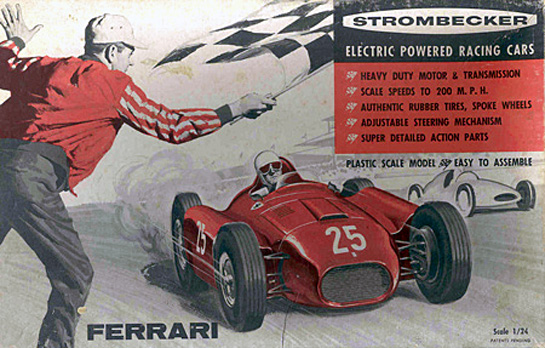
Strombecker's Lancia-Ferrari D50, before being set up for slot car tracks. The original receipt for this model was found in the box. It was sold on October 27th, 1960, at Bowen's Toyland in the Bedford Shopping Center in Bedford Massachusetts. The cost was $1.29.
Two brothers discuss a tradition of slot car racing that started in 1960
1959-1966 By Pete Vack
In December of 1957, Sports Cars Illustrated published an article about a Scalextric/Triang slot car set that author Bob Coogan had found at Polks Hobby Shop in New York City. Coogan called the table top track “The Ultimate Christmas Gift”. It was a great story, and clearly, a kid could get pretty juiced up on this new hobby. We’d have to wait for a while, but this was one young sports car nut that simply had to have a slot car track. There were no ifs, ands, or doubts about it. Remembering those days allows one to understand the tremendous anticipation of the latest version of the Ipad.
SCI set the wheels in motion that eventually resulted in the placement of a Strombecker slot car track under the Christmas tree in 1959, when I was 11 years old. As we’ll relate below, remarkably, almost a half century later, at least one member of the Vack family is still in the slot car groove.
Strombecker was out of Moline Illinois, and had been making a line of very nice plastic models with electric engines. These models could either be run free with a small battery pack, or could be used with a tether wire and circle endlessly. The line included a D Type Jag, a 250F Maserati, a W196 Mercedes and the D50 Lancia Ferrari. They were then very nicely scaled and detailed 1/24 models, and are still very nice. Strombecker tooled up some track very much in the mold of Scalextric, and equipped their two-pole electric motor powered model cars with a pickup (which actually steered the models) and they were off to the races.
Over the next few years we set aside a corner of the basement and an 8×4 table and began to build and equip a full slot car setup. The original oval track soon grew into a full circuit, and the number of cars grew as I could afford them.
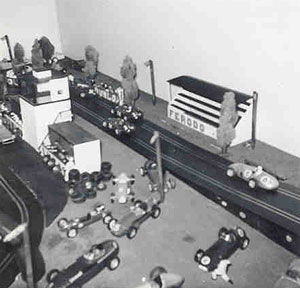
The Vack track circa 1961. All the buildings were made of balsa wood. Most of the cars off track are Merrit models, including a Simca-Gordini and Talbot-Lago.
I bought Scalextric cars, which although at 1/32, seemed to do fine with the 1/24s. The entire lineup of Merritt kits added to the realism of the layout. The Merritt kits were even better detailed than the Strombeckers, only the fake wire wheels let the model down. (I always wanted to find the series of Merritt kits again, unsullied by Dupont glue. And finally, I did. The whole set, and others I’d never even seen before. They were hidden in a closet at Bill Green’s house in Watkins Glen. No, he won’t sell. EVER!)
I’m not sure why my parents opted for the Strombecker layout; perhaps it was less expensive, perhaps it was easier to obtain. I do remember, however, that I was definitely the first on my block, my neighborhood, and my hometown to own a slot car track.
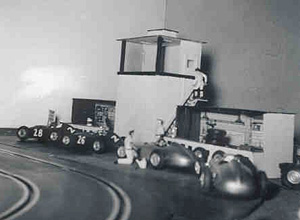
A pit scene, again about 1961. The buildings looked crude but were far less expensive than the Scalextric offerings.
For the next three, maybe four years, the track grew and grew and the cars grew faster and faster. But suddenly, we moved, the track was packed away, I started to shave and girls became more important than new brushes for the slot car motors. The track languished, hastily set up in our new basement, but largely now ignored. At fifteen, I had my driver’s license and that, as they say, was that.
Eventually, college and Viet Nam called. I was outta there, but left my younger brother Greg in charge of the racetrack. We’ll let him pick up the story from there.
1966-2010 by Greg Vack
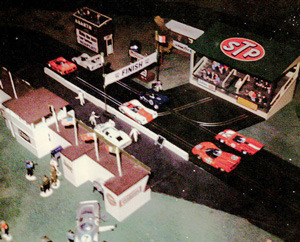
Vack track Mark 2, Circa 1967. The Can-Am grid. Most of these cars had clear plastic bodies that I detailed and mounted on old chassis. Pits from Scalextric, grandstand from Strombecker. Note the LeMans start track.
Some of my earliest memories are of racing against my brother using the little tin friction-motor cars that were coming in from Japan in the late fifties. We’d back them up on the kitchen floor to power the motors and then release them to shoot down the tile and crash into the wall. We’d lie down on the floor so we could get the view of them as if they were real race cars. The motors would fail or the wheels would detach from the axles after just a few runs; they were “tinny Japanese toys” after all. But I loved every minute of time playing with my big brother. And then Pete got the slot car track. He would occasionally allow me to race one of the somewhat fragile cars, but being seven years younger, I was never able to compete with him. Like his idol, Stirling Moss, he would get off to an early lead that he would never relinquish. He would carry off the tiny 1/24 scale trophy and I would storm upstairs crying to our parents about how unfair it all was.
When Pete left for Vietnam, he was transformed in my young eyes from the evil teenager who relentlessly teased me, into an adult role model whose every act I wanted to emulate. Thank God I got over that, but it stirred the passion in me for all things automotive, which had lain dormant for several years, and the Christmas of 1966 saw a Strombecker slot car track under the tree for me. Perhaps not coincidentally, I was the same as age Pete was when he found his under the tree. The old track had been taken apart when we had moved and a number of the accessories were gone but most of the old slot cars and parts were there for me to work with. Our father once again set about helping one of his sons build a slot car table and again saw most of his basement disappear.
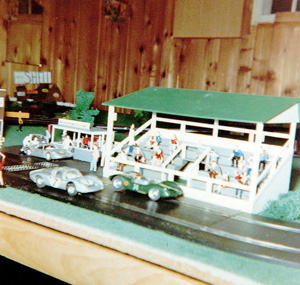
Somewhat earlier shot of same track showing the Lotus 30 that came with the original set. In the far background there is a very homemade SHELL billboard. The internet now allows easy download, scaling and printing of virtually any logo.
The mid-sixties were the golden age of slot car racing, and beautiful kits of contemporary cars from companies like Monogram and Revell soon replaced the Strombecker models, which typically had nicely detailed bodies, but poor mechanicals. I would spend every penny I had at Martin Carr’s hobby shop in Duluth. He kept a huge inventory and I’d drag my father down there on Saturdays where I carefully inspected every kit to see which one would be the best addition to my collection while he patiently chatted with the owner. I’d pour over the Auto World catalog and send away for more exotic parts like clear plastic bodies so that I could update the mid sixties sports cars with the latest Can-Am bodies.
Although Scalextric never had very good distribution in the US, and their cars were even less competitive than Strombecker’s, they had wonderfully detailed accessories, some of which are still made today. For a couple of Christmases and birthdays those exotic toys from England were the core of my gift requests.
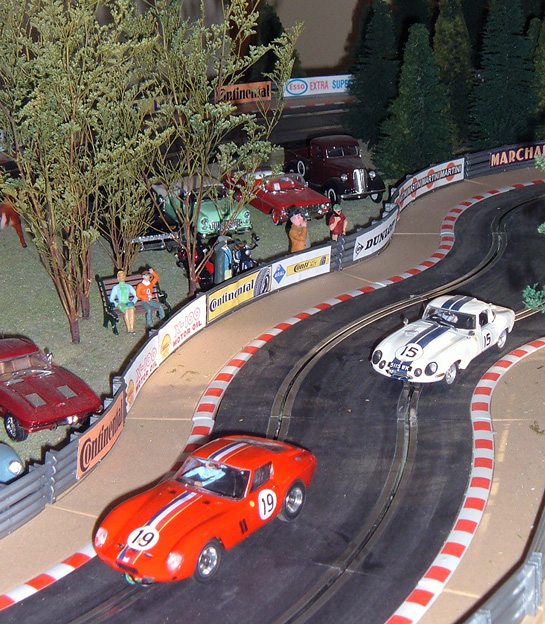
Vack track Mark 3, circa 2007. The Ferrari 250 GTO is an old Strombecker model I restored and detailed as the Noblet\Guichet car that finished second at Le Mans in 1962. Decals are from Patto’s. The Jaguar XKE is a new release from a resurrected Monogram name. Produced by the factory in several versions, this one is the Cunningham\Grossman car from Le Mans ‘63.
As the sixties came to an end and I too started to shave and chase girls, the track met the same fate as my brother’s. Slot car racing itself went in a long and steep decline, with most of the US companies folding by the mid-seventies. After I went away to college, our parents cut up the table and sold off the track and accessories, and that was that.
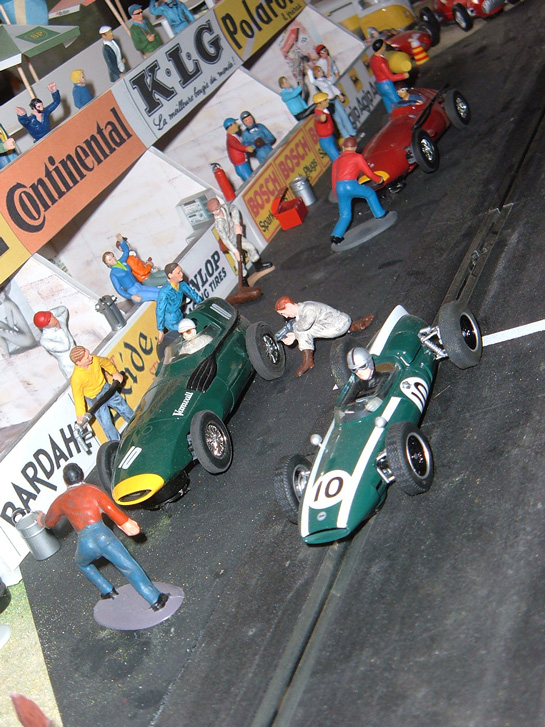
Pit scene from current track. The pits are hand made from foam-core, loosely based on period photos of the pits at Rheims and Monza. Most of the pit figures are from Scalextric and have probably been in continuous production since the first Vack track. All three cars are from Scalextric.
But not really, at least for me. Both Pete and I dabbled with HO tracks that could be easily taken up and down and I thought about building another track, but life always intruded. Then two years ago, some 46 years after the first slot car track came into the Vack household, under my Christmas tree was a new 1/32 digital set from Scalextric, which had managed to survive, thanks to a European slot car market that had never quite disappeared. Digital slot cars have changed the rules. Now you can race up to six cars simultaneously on a track with only two slots, with lane changing controlled by the drivers. Computer controlled starts and finishes, precisely measured lap times and even pit stops made necessary by the computer stopping the car on the circuit if you drive too many laps without coming in to refuel, have brought new life to the hobby.
Just as interesting are the beautiful cars produced by the manufacturers. Generally built in small batches, virtually every important racing car of the last sixty years has been precisely reproduced to the last detail. So the Maserati 250F built by Scalextric a couple of years ago has all the markings of the car Fangio famously drove to win at the Nurburgring in 1957 and the companion Vanwall is Moss’s car from the same race. They are so lovely that many collectors never race their cars, using them for display as they would die-casts. But that’s a waste.
Or if you want to race an old Strombecker car, you can find one easily on Ebay, modify the mechanicals, digitize it and restore the body using the incredible range of accurate period decals that you can order on-line from Bruce Patto in Australia or several others. My next pet project is to restore a Strombecker BRM P57 as driven by Graham Hill to win at Zandvoort in ’62.
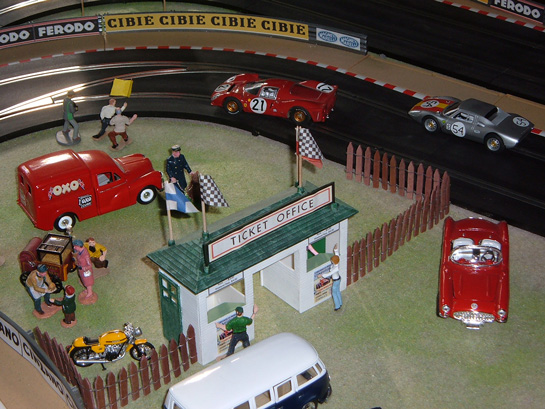
Scalextric Ferrari P4 followed by Monogram Porsche 904. Both are sold completely pre-painted and detailed. The Porsche is produced using the original model from the sixties. The ticket office is Strombecker Ebay find, and the wonderful die-cast Morris delivery truck was found on the toy rack at our local grocery store. Note the digital lane change track. To change lanes the driver transmits a signal from his car to a receiver in the track that activates a solenoid redirecting the car onto the other lane.
And so now in middle age I can again eagerly anticipate finding new toys under the Christmas tree. A second childhood? Maybe, but so what? And I still like putting my head down by the track so that they look like real cars going by.
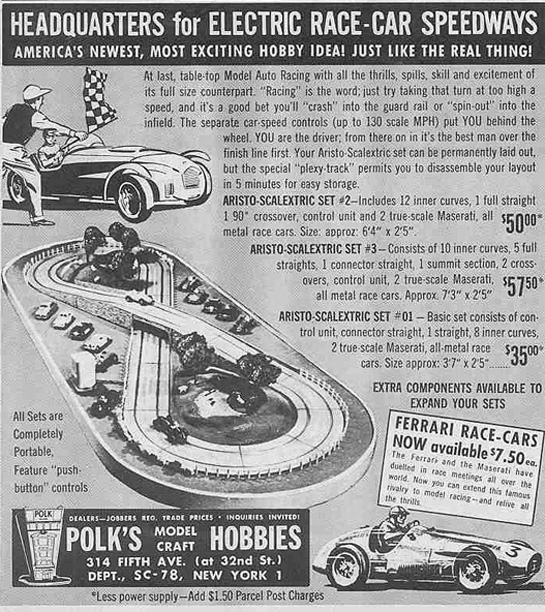
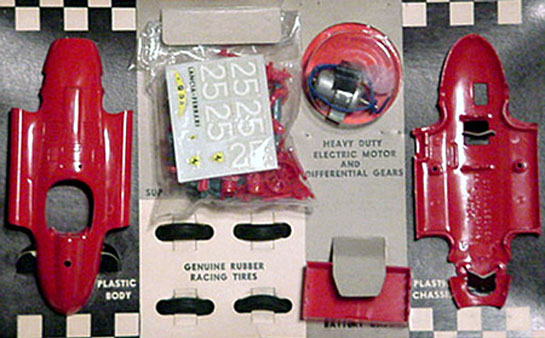
Pete,
Thanks for doing the slot car article again. It brings back such great memories of my nearly fifty years in the hobby business, through both the orginial and the rebirth of the slot car craze.
When are you coming to Richmond again? You need to visit the slot track again sometime.
Have a great Christmas and New Year.
Cheers,
Bob
Hi Pete
I loved hearing your story about your tack…it reminded me of my own circuits I built in South London in the 60’s. Mine never had the atmosphere that you created though although they were good to drive on…I am very jealous! I am now in the process of building a custom track in wood for my sons…or is it for me?…I am not sure…as I still have the bug.
Cheers
Nic
My mother-in-law got me started back in slot cars back in the late 90s (It was Scalextric for me too). Prior to that I also had given them up in the late 60’s after discovering girls, and a stint in the Air Force.
When things got rolling for me the second time around I was living in Illinois. I quickly started buying, modding and building my own slot cars. I moved to the Northwest after my wife died in 2008 to be closer to family (grand kids don’tchaknow)… and a more active slot cars community.
I’ve even gotten to the point of making my own bodies, carving them in bass wood then making latex molds and casting them in resin. Wait till you guys discover proxy racing… if you haven’t already.
I had a Strombecker set that was purchased at Polk’s around 1965.
The cars were a Jag D-type and a Ferrari 250 GTO.
A rush of memories. I used to purchase all my hobby materials from Bowen’s in Bedford, Mass; plastic kits, slot cars and balsa/silkspan gas engine airplanes. Still have a couple uncompleted kits on my shelf. We would go to Bowen’s and spend many hours looking and wishing for the latest whatever. Remember the awe we had for that strange rear engine Lotus Indy slot car we made. There was a commercial slot track not that far away, it was huge, and boy did some of those racers fly, both on and off the track, had to duck at times. Incoming!! Foam tires were the trick set up. At college had a friend who brought his set up and it was lowered from the ceiling so races were always at hand. I may have to head back to my mom’s attic and retrieve my Aurora AFX stuff.
Cal
I too had long forgotten my Scalextric days in the sixties, but that now brings up one of my favourite ‘don’t try this at home’ stunts.
In Britain we used 240 volts from the mains reduced to 12V by a simple transformer. As the track got assembled and then torn apart so many times, the joints used to weaken and that sometimes led to a break in the current when a car went over and jolted a weak connection.
Ok, probably happened a lot you may think, but how many kids were dumb enough to try to test the track by sticking their tongue on the copper strips ?!?!
12 volts DC gives a little buzz, but if the fault had been due to the transformer failing I may have got a mouthful of 240 big ones !